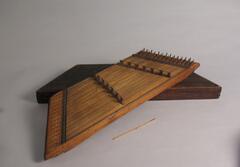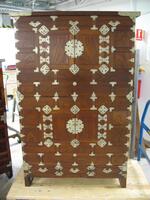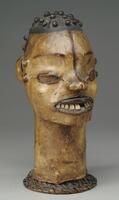27 UMMA Objects
27 UMMA Objects

Korean (Korean (culture or style))
Hammer-dulcimer (Yanggeum)
1850 – 1950
Gift and partial purchase from Bruce and Inta Hasenkamp, purchase with funds from Elder and Mrs Sang-Yong Nam
2021/1.158
![Large oblong, rectangular wooden bowl with rounded ends.<br />
<br />
These large bowls (<em>hamji</em>) were made by carving out large, single pieces of wood. Notches or handles have been carved out on two opposite sides of the outer walls, making them easy to carry. Round hamji bowls were sometimes carved on a turning lathe, but those with notches could be made by carving out single lengths of wood with an adz. These bowls were used in towns and the countryside alike. Affluent households would possess sets of large, medium-sized, and small bowls with notches piled up together. When grinding mung beans, beans, or red beans, such bowls are placed below a grindstone supported by a tripod.
<p>[Korean Collection, University of Michigan Museum of Art (2017) p. 274]</p>
Large oblong, rectangular wooden bowl with rounded ends.<br />
<br />
These large bowls (<em>hamji</em>) were made by carving out large, single pieces of wood. Notches or handles have been carved out on two opposite sides of the outer walls, making them easy to carry. Round hamji bowls were sometimes carved on a turning lathe, but those with notches could be made by carving out single lengths of wood with an adz. These bowls were used in towns and the countryside alike. Affluent households would possess sets of large, medium-sized, and small bowls with notches piled up together. When grinding mung beans, beans, or red beans, such bowls are placed below a grindstone supported by a tripod.
<p>[Korean Collection, University of Michigan Museum of Art (2017) p. 274]</p>](/media/W1siZiIsIjIwMjIvMDkvMjQvMmFtMWgzNXk0c19kZWZhdWx0LmpwZyJdLFsicCIsInRodW1iIiwiMjQweDIwMCJdXQ?sha=abbd1ecb4867c0dc)
Korean (Korean (culture or style))
Wooden Bowl
1850 – 1950
Gift of Ok Ja Chang and the Chang Family
2009/2.29
![Wooden table with a dodecagon table top and rounded out legs.<br />
<br />
This dog-legged tray-table has its name derived from the shape of its curved legs which resemble those of dogs. The table top and its raised brim are made from the same single piece of thick board. Aprons between the legs, immediately under the table top, are not shaped in identical proportion, as they were initially made long and were shortened where it was needed. Bamboo pegs are driven into the table top to join it with the aprons, and the stretchers are nailed to the legs by nails driven in from the bottom.
<p>[Korean Collection, University of Michigan Museum of Art (2017) p. 258]</p>
Wooden table with a dodecagon table top and rounded out legs.<br />
<br />
This dog-legged tray-table has its name derived from the shape of its curved legs which resemble those of dogs. The table top and its raised brim are made from the same single piece of thick board. Aprons between the legs, immediately under the table top, are not shaped in identical proportion, as they were initially made long and were shortened where it was needed. Bamboo pegs are driven into the table top to join it with the aprons, and the stretchers are nailed to the legs by nails driven in from the bottom.
<p>[Korean Collection, University of Michigan Museum of Art (2017) p. 258]</p>](/media/W1siZiIsIjIwMjIvMDkvMjQvNzRsNmlobWYwc19kZWZhdWx0LmpwZyJdLFsicCIsInRodW1iIiwiMjQweDIwMCJdXQ?sha=2edc8f3a2585cc9d)
Korean (Korean (culture or style))
Wooden Table
1850 – 1950
Gift of Ok Ja Chang and the Chang Family
2009/2.34
![A rectangluar box woven with bamboo. There is a strip of bamboo with a clasp to keep the basket closed and in one piece. Used as a fermer's lunchbox.<br />
<br />
This lunchbox is woven from strips of bamboo. The outer part is plain-woven, while the inner part is woven in the style of a reed mat. The frame is made from bands of bamboo tied together in two places. Lunchboxes such as this one were used to deliver meals to those working in fields.
<p>[Korean Collection, University of Michigan Museum of Art (2017) p. 278]</p>
A rectangluar box woven with bamboo. There is a strip of bamboo with a clasp to keep the basket closed and in one piece. Used as a fermer's lunchbox.<br />
<br />
This lunchbox is woven from strips of bamboo. The outer part is plain-woven, while the inner part is woven in the style of a reed mat. The frame is made from bands of bamboo tied together in two places. Lunchboxes such as this one were used to deliver meals to those working in fields.
<p>[Korean Collection, University of Michigan Museum of Art (2017) p. 278]</p>](/media/W1siZiIsIjIwMjIvMDkvMjQvMW04NXo0anoyNl9kZWZhdWx0LmpwZyJdLFsicCIsInRodW1iIiwiMjQweDIwMCJdXQ?sha=39da02e99668303f)
Korean (Korean (culture or style))
Farmer's Lunchbox
1850 – 1950
Gift of Ok Ja Chang and the Chang Family
2009/2.50
![A large rectangular brass-colored metal bar lock, similar to a u-bar lock, meant to use as a lock for a chest.<br />
<br />
This pipe-shaped lock is made of nickel. The key has been lost. The protruding part at the left end is decorated with six incised rings/
<p>[Korean Collection, University of Michigan Museum of Art (2017), 246]</p>
A large rectangular brass-colored metal bar lock, similar to a u-bar lock, meant to use as a lock for a chest.<br />
<br />
This pipe-shaped lock is made of nickel. The key has been lost. The protruding part at the left end is decorated with six incised rings/
<p>[Korean Collection, University of Michigan Museum of Art (2017), 246]</p>](/media/W1siZiIsIjIwMjIvMDkvMjQvMzFsOHI1eTE1cl9kZWZhdWx0LmpwZyJdLFsicCIsInRodW1iIiwiMjQweDIwMCJdXQ?sha=d4e1d7e5d6bbfa83)
Korean (Korean (culture or style))
Lock for Chest
1850 – 1950
Gift of Ok Ja Chang and the Chang Family
2009/2.59
![A large rectangular metal bar lock, similar to a u-bar lock fitted with a key made up of two metal strips in the shape of a wedge, meant to use as a lock for a chest.<br />
<br />
Pipe-shaped locks such as these were used for locking boxes and chests. Their keys have been lost. Each of their bodies was made by forging two plates before soldering them together.
<p>[Korean Collection, University of Michigan Museum of Art (2017), 246]</p>
A large rectangular metal bar lock, similar to a u-bar lock fitted with a key made up of two metal strips in the shape of a wedge, meant to use as a lock for a chest.<br />
<br />
Pipe-shaped locks such as these were used for locking boxes and chests. Their keys have been lost. Each of their bodies was made by forging two plates before soldering them together.
<p>[Korean Collection, University of Michigan Museum of Art (2017), 246]</p>](/media/W1siZiIsIjIwMjIvMDkvMjQvNnkxMm5vZWlycF9kZWZhdWx0LmpwZyJdLFsicCIsInRodW1iIiwiMjQweDIwMCJdXQ?sha=373b5cc80a6ccfc3)
Korean (Korean (culture or style))
Lock for Chest
1850 – 1950
Gift of Ok Ja Chang and the Chang Family
2009/2.61
![A round metal lock meant to lock a chest. The front of the metal disc is decorated with a line carving of a Korean character surrounded by multiple carved circles, but leave a rim of undecorated metal around its edges.<br />
<br />
This lock opens when the key is inserted into the hole at the bottom. Locks of this type were used for locking chests or stacked chests. The key has been lost. The Chinese character “longevity (壽)” is incised on the center of the upper surface against ringmat ground.
<p>[Korean Collection, University of Michigan Museum of Art (2017), 247]</p>
A round metal lock meant to lock a chest. The front of the metal disc is decorated with a line carving of a Korean character surrounded by multiple carved circles, but leave a rim of undecorated metal around its edges.<br />
<br />
This lock opens when the key is inserted into the hole at the bottom. Locks of this type were used for locking chests or stacked chests. The key has been lost. The Chinese character “longevity (壽)” is incised on the center of the upper surface against ringmat ground.
<p>[Korean Collection, University of Michigan Museum of Art (2017), 247]</p>](/media/W1siZiIsIjIwMjIvMDkvMjQvMjA3c2N6YXFyMF9kZWZhdWx0LmpwZyJdLFsicCIsInRodW1iIiwiMjQweDIwMCJdXQ?sha=c94058c2416b92ad)
Korean (Korean (culture or style))
Lock for Chest
1850 – 1950
Gift of Ok Ja Chang and the Chang Family
2009/2.87
Mauritanian (Mauritanian (African national style))
Milk Bowl
1875 – 1925
Gift of Mark and Marie-Armande Wilson
2018/2.78

Korean (Korean (culture or style))
Chest (in three pieces)
1850 – 1950
Museum Purchase made possible by the Margaret Watson Parker Art Collection Fund
2009/2.25A-C
![A rectangluarly shaped woven basket with rounded edged. The bottom half and the lid of the basket are trimmed with strips of pine. The two pieces are of two slightly different sizes, making the lid fit into the bottom piece.<br />
<br />
These wicker baskets are rimmed with willow strips on both the interior and the exterior. Wicker baskets such as these were used as sewing baskets, food containers, or for other various purposes. The willow strips are sewn firmly together at their joints. On one each side of the lid and body of plate 358 (2009/2.56) is a faded inscription written that reads “Seong □ 2-gu Bongsandaek (성□2구 봉산댁; possibly a reference to a lady from Bongsan, living in Seong □ 2 [i]-gu).”
<p>[Korean Collection, University of Michigan Museum of Art (2017) p. 278]</p>
A rectangluarly shaped woven basket with rounded edged. The bottom half and the lid of the basket are trimmed with strips of pine. The two pieces are of two slightly different sizes, making the lid fit into the bottom piece.<br />
<br />
These wicker baskets are rimmed with willow strips on both the interior and the exterior. Wicker baskets such as these were used as sewing baskets, food containers, or for other various purposes. The willow strips are sewn firmly together at their joints. On one each side of the lid and body of plate 358 (2009/2.56) is a faded inscription written that reads “Seong □ 2-gu Bongsandaek (성□2구 봉산댁; possibly a reference to a lady from Bongsan, living in Seong □ 2 [i]-gu).”
<p>[Korean Collection, University of Michigan Museum of Art (2017) p. 278]</p>](/media/W1siZiIsIjIwMjIvMDkvMjQvNG0xb3JlcWlnMV9kZWZhdWx0LmpwZyJdLFsicCIsInRodW1iIiwiMjQweDIwMCJdXQ?sha=349fad738bc188d5)
Korean (Korean (culture or style))
Lidded Basket for Sewing
1850 – 1950
Gift of Ok Ja Chang and the Chang Family
2009/2.51
![A pillow-shaped woven basket with a lid used for storing sewing materials. Made of two parts, each with a lip of pine. The two pieces are sized differently in order to fit together as a lidded container.<br />
<br />
These wicker baskets are rimmed with willow strips on both the interior and the exterior. Wicker baskets such as these were used as sewing baskets, food containers, or for other various purposes. The willow strips are sewn firmly together at their joints. On one each side of the lid and body of plate 358 (2009/2.56) is a faded inscription written that reads “Seong □ 2-gu Bongsandaek (성□2구 봉산댁; possibly a reference to a lady from Bongsan, living in Seong □ 2 [i]-gu).”
<p>[Korean Collection, University of Michigan Museum of Art (2017) p. 278]</p>
A pillow-shaped woven basket with a lid used for storing sewing materials. Made of two parts, each with a lip of pine. The two pieces are sized differently in order to fit together as a lidded container.<br />
<br />
These wicker baskets are rimmed with willow strips on both the interior and the exterior. Wicker baskets such as these were used as sewing baskets, food containers, or for other various purposes. The willow strips are sewn firmly together at their joints. On one each side of the lid and body of plate 358 (2009/2.56) is a faded inscription written that reads “Seong □ 2-gu Bongsandaek (성□2구 봉산댁; possibly a reference to a lady from Bongsan, living in Seong □ 2 [i]-gu).”
<p>[Korean Collection, University of Michigan Museum of Art (2017) p. 278]</p>](/media/W1siZiIsIjIwMjIvMDkvMjQvOGJ6dWJ2eXd1ZV9kZWZhdWx0LmpwZyJdLFsicCIsInRodW1iIiwiMjQweDIwMCJdXQ?sha=b20483f9f781a9cc)
Korean (Korean (culture or style))
Lidded Basket for Sewing
1850 – 1950
Gift of Ok Ja Chang and the Chang Family
2009/2.56
Loading…

